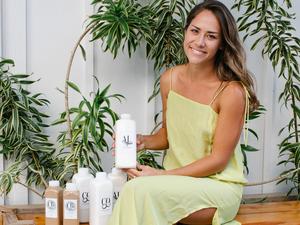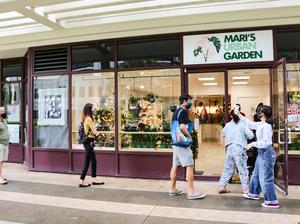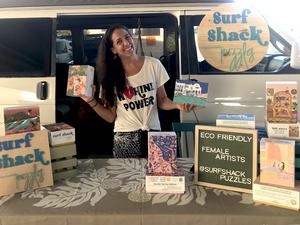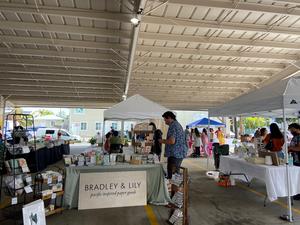Attaining balance in life is no easy feat in the best of times.
Finding it in the tourism-driven world of Hawaii retail, which has been rocked to its core during a period of social and economic upheaval, is an especially exacting endeavor.
Whether it’s reaching a compromise between concern and idealism as the Covid-19 pandemic nears the one-year mark, or locating the sweet spot between brick-and-mortar and online operations, or choosing whether to collaborate or compete with their neighbors, local businesses are confronted by a juggling act on multiple fronts in order to survive.
In 2019, out-of-market visitors brought in nearly $18 billion, according to the Hawaii Tourism Authority. For many local retailers, that once-deep well has run dry, including in governmental support like Paycheck Protection Program Loans and small business grants.
“We’re now at the real tipping point,” said Robbie Melton, Kauai director of the Hawaii Small Business Development Center, during Pacific Business News’ Retail Roundtable held virtually on Jan. 29.
She was one of five panelists to offer thoughts on this pivotal time, along with Crazy Shirts President Scott Maroney; Tina Yamaki, president of the Retail Merchants of Hawaii; Kahala Mall General Manager Ezy Paeste; and Ala Moana Center General Manager Jacob Wilson.
Online vs. Brick and mortar
Every week, Yamaki makes an effort to walk around a shopping center on Oahu to talk to customers, sales associates and shop managers — in the past, she’d cover the Neighbor Islands, too, but that’s become more difficult.
A recurring theme? Local retail businesses’ acceleration to the online realm for both sales and marketing. It’s become all about the omni-channel approach, she said, noting some fresh shutterings of brick-and-mortar businesses in the first week of January.
“Businesses have really pivoted to online,” Yamaki said. “It’s not just, ‘I’m going to open up a store now.’ They might have had 25 items [on the web] before; well now, they’re putting their whole store online. They had to figure out how to do that. Those that did were more successful, especially the local businesses. Those that don’t have an online presence, they’re having a harder time.”
But B&M still has its place right now, especially as distribution centers.
Paeste, a former construction head with MMI Realty who previously ran Kamehameha Shopping Center, said a couple of tenants at Kahala Mall actually exceeded sales in 2020 from 2019, despite the state’s mandated shutdowns of non-essential businesses at times last year.
Kahala has seen Covid-related shutterings of three stores to this point — Banan, Riches Kahala, and The Walking Store. But 95% of Kahala’s vendors are up and running, Paeste said.
“We were very busy over the holidays. Most of our tenants were very pleased with their sales result.”
Wilson, who’s been GM at the world’s largest open-air mall since November after stops in Colorado, Wyoming and Louisiana, noted the creation of specific lines for quick transactions for in-store pickups that would not count toward the limited store occupancy of his vendors due to social-distancing rules.
“I don’t necessarily view brick and mortar and online as two competing ways of doing business, necessarily,” Wilson said. “I think as a retailer you want to think about, I want to be where the customers want me to be. You need to be able to do both. I think several retailers were able to pivot to that really well. Buy online and pick-up in store.”
Maroney pointed out that now, 70% of people start their shopping experience online, on either websites or social media, to scout a product before either purchasing it there or going into a physical location to find it.
He said 10 years ago, when Crazy Shirts delved into online sales, about 2% of sales came from that. Before the pandemic it was 30%. Now it’s 90-10 online. Ideally, he’d like to get it to 50-50.
“Online really became the big focal point for us,” Maroney said. “Obviously, we can reach more customers and more fans [that way.] So we did see a significant jump in sales from basically the beginning of November to the end of December, record sales, which is great. Nothing to offset the [in-person sales of] 24 stores we have in Hawaii – to offset that is quite challenging.”
Then there’s the rise of the pop-up store, which acts as a hybrid of sorts from traditional brick-and-mortar and the convenience of online shopping.
Melton pointed out that they’re cheaper to operate than a brick-and-mortar store, create buzz on social media and by word of mouth, and generally bring in good sales for vendors.
That’s especially true on the Garden Isle, population 72,000, where many retailers don’t have an online presence.
“That’s going to be one of the ways people operate in the near future,” Melton said. “A number of groups created pop-ups so people could bring their goods. We have a lot of crafters here. The residents here all want to support local. They did their best to support local, instead of doing online shopping.”
Even larger shopping centers like Kahala Mall and Ala Moana have gone the pop-up route in newly vacant spaces. Ala Moana did several for one-month terms during peak holiday season in December.
“You get to test the waters and how the market responds to your offering, and maybe you can grow from there,” Wilson said.
Yamaki compared pop-ups to the dating scene, with the upside being a lack of commitment.
“You want to see, is that the customer base that I’m going to have? Is this what people want to buy? You’re not stuck in a long-term lease as a brick-and-mortar,” she said.
Paeste said that one of Kahala’s current vendors is setting up a pop-up into the space formerly occupied by The Walking Company, featuring PPE — a popular source of revenue for many merchants over recent months — and indoor plants.
If such operations like that are successful, they could become a permanent store, Paeste pointed out.
Concern vs. Hope
Whether it’s supply chain problems, a rise in cybertheft, or landlords giving less leeway on deferred rent payments, there’s plenty of things retail businesses have to worry about right now.
Melton, who works with startups as well as established small businesses, has witnessed increasing desperation as the months of the pandemic have worn on.
“People are going, ‘OK, my first round of PPP ran out, now there’s a new round of CARES Act funding, but how long is that going to take?’” she said.
She pointed to a December survey of more than 100 Garden Isle business owners conducted by the Kauai Chamber of Commerce, in which about 49% of respondents said they thought they’d go out of business within 90 days if there was not a significant return of tourism.
Melton is hopeful for more CARES Act funding to come through and the vaccine to be effective.
Paeste’s concerns included financial support for her tenants and the lack of advance notice given to businesses previously in shifts in the state’s tiered Covid recovery system.
She wondered aloud whether shoppers’ habits would revert to the pre-pandemic norm.
“Is it going to be the same, total back to normal going back to the mall and visiting merchants in person? Are they just going to do curbside, online shopping? We’re trying to plan for what that new norm will be, after.”
But, Paeste said, “The vaccine gives a lot of hope for a lot of people. Hopefully that can be available to the general public very soon.”
Wilson, a self-described optimist who views challenges as opportunities, worked his way up through the shopping mall industry going back to his days as an overnight mall security officer in his hometown in Colorado.
“I think people can anchor themselves to hope, and there are a lot of bright spots to look forward to,” he said. “We’ve largely, through 2020, had to figure out how to operate, how to live differently. Many people had to become teachers at home for their children. I think coming into 2021, we look back and say, ‘Wow, look what we were able to accomplish. Look at how we were able to adapt and change.’ And then say, we might be stronger for it. … But also acknowledge that we’re not through this yet and there’s some difficult decisions people have to make.”
Yamaki mourned the end of programs like the Hawaii Restaurant Card, because expenses, if anything, are mounting.
“The largest single monthly expense that businesses have is their commercial lease rent,” Yamaki said. “And that’s the scary part for a lot of them. There are a lot of businesses that are hanging on; they’ve already used up their kids’ college funds, wedding funds, secret savings, all of that is gone. Some have sold their homes just so their businesses can survive. Those are the stories I’ve heard, and it’s really sad.”
She is regularly in touch with politicians in her role with the Retail Merchants of Hawaii. She’s hopeful some can be persuaded to take action.
“As we move into this legislative session, a lot of officials have seen how hard a hit business is taking. If business isn’t strong, we’re not going to have jobs for our local people.”
Maroney, speaking on behalf of entrepreneurs everywhere, expressed distaste for the word “hope.”
When the going gets tough, the five-year president of 57-year-old Crazy Shirts gets more hands-on. He said he went back “into the weeds” throughout the pandemic — even going to chip in on packaging work in Crazy Shirts’ Colorado shipping facility.
“We like to go do it, let’s go figure this out. I am very, very excited about what we have learned over 2020, even though it was very challenging,” Maroney said. “You get a lot more out of people and what we’re capable of doing when you’re put under pressure to get the job done. And what we’ve seen as an organization is the amount of people who have just rise-and-shined throughout this process, going above and beyond to get the job done. That really, really excites me for the future.
“When all this comes out and people can freely start traveling again, you believe me they will be on that plane and start coming to Hawaii. … They will come. Just like quoting ‘Field of Dreams’ or something there. It will happen. It’s just navigating to get to that point again.”
Team spirit
There was broad agreement on the panel that in the close-knit Hawaii retail community, cooperation between businesses has endured, with minimal fraying throughout the pandemic.
Yamaki witnessed a number of local businesses in disparate wares coming together in the early days of the pandemic, when PPE was hard to find. More recently, she’s tried to direct resources to merchants on Kauai, Maui and Hawaii Island, even to non-members of her group.
“We’re a membership-based organization, so it would be easy for me to say, ‘You’re not a member, we don’t help you.’ But we don’t do that. We want to see everybody survive and come out of this.”
Kauai, in particular, has come together to try to get through the crisis, Melton said. According to critics, the Garden Isle’s only-partial adoption of the pre-travel testing program for Mainland visitors has limited tourism.
Kauai’s open-air shopping centers, like Kukui Grove, have routinely implemented live music outside shops to try to increase foot traffic.
“We are a small island. Even without Covid, I don’t see any cutthroat businesses,” Melton said. “Everyone pulls together and works really hard to support each other.”
Maroney pointed out the need for people to help tourism-dependent places like 3,800-acre Kualoa Ranch that still have fixed costs to maintain themselves.
“As business owner to business owner, we’re very collaborative to this day,” Maroney said. “We want everyone to be here for the long run. Every single retailer, every single company. I’m willing to take a call, jump on a conference call, to let everyone know what Crazy Shirts is doing or will do for the current situation of Covid or ongoing business.”
Paeste and Wilson have witnessed plenty of collaboration at their malls.
“One of my favorite stories … was about Roberts Hawaii’s visitor concierge here,” Wilson said. “It’s hard to be a visitor concierge without visitors. Their business model was really upside-down. They used their fleet and resources to think creatively and execute a same-day store-to-door delivery service on the island of Oahu. Additionally, they helped execute our curbside delivery program here at the shopping center. That type of collaboration, they talked to all the retailers here and had some really good buy-in from the local businesses.”
Paeste felt that, in the end, the local community will back up businesses.
“I don’t think that shopping centers will ever go away,” she said. “I think it’s a part of people’s lifestyle. There’s the beach, and then they’ve gotta go somewhere to eat, and usually the next stop is at a shopping center. However we come out after this pandemic, we’ll be stronger.”








